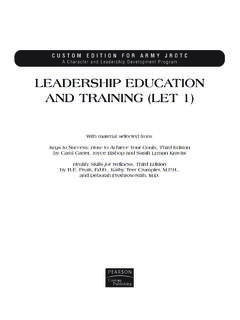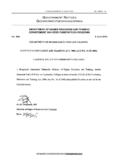Transcription of LEADERSHIP EDUCATION AND TRAINING (LET 4)
1 LEADERSHIP EDUCATION . AND TRAINING (LET 4). With material selected from: Developing LEADERSHIP Abilities, by Arthur H. Bell and Dayle M. Smith CUSTOM EDITION FOR ARMY JROTC. A Character and LEADERSHIP Development Program Cover images courtesy of Army JROTC. Excerpts taken from: Developing LEADERSHIP Abilities By Arthur H. Bell and Dayle M. Smith Copyright 2002 by Prentice-Hall, Inc. A Pearson EDUCATION Company Upper Saddle River, New Jersey 07458. Copyright 2005, 2002 by Pearson Custom Publishing All rights reserved. This copyright covers material written expressly for this volume by the editor/s as well as the compilation itself. It does not cover the individual selections herein that first appeared elsewhere. Permission to reprint these has been obtained by Pearson Custom Publishing for this edition only. Further reproduction by any means, electronic or mechanical, including photocopying and recording, or by any information storage or retrieval system, must be arranged with the individual copyright holders noted.
2 The term Thinking Maps and the term Thinking Maps with the graphic forms of the eight Maps have registered trade- marks. No use of the term Thinking Maps with or without the graphic forms of the eight Maps may be used in any way without the permission of Thinking Maps, Inc. For use of Thinking Maps in the classroom, inquiries regarding Thinking Maps and TRAINING can be made to Thinking Maps, Inc., 1-800-243-9169, Printed in the United States of America 10 9 8 7 6 5 4 3 2 1. ISBN 0-536-85156-5. 2004420248. DG/JS. Please visit our web site at PEARSON CUSTOM PUBLISHING. 75 Arlington Street, Suite 300, Boston, MA 02116. A Pearson EDUCATION Company Brief Contents Unit 1 Citizenship in Action 1. Chapter 2 Service to the Nation 2. Unit 2 LEADERSHIP Theory and Application 27. Chapter 6 LEADERSHIP Principles 28. Unit 3 Foundations for Success 68.
3 Chapter 11 NEFE High School Financial Planning Program 69. Chapter 12 Teaching Skills 74. iv Brief Contents Appendix Mandatory Core Service Learning 119. Chapter 8 Making a Difference with Service Learning 120. Index 141. Table of Contents Unit 1 Citizenship in Action 1. Chapter 2 Service to the Nation 2. Lesson 1 The Department of Defense 3. Lesson 2 The Active Army 9. Lesson 3 The Army Reserve Components 18. Unit 2 LEADERSHIP Theory and Application 27. Chapter 6 LEADERSHIP Principles 28. Lesson 1 Power Bases and Influence 29. Lesson 2 Styles of LEADERSHIP 34. Lesson 3 Management Skills 42. Lesson 4 Communication 49. Lesson 5 Motivation 59. vi Table of Contents Unit 3 Foundations for Success 68. Chapter 11 NEFE High School Financial Planning Program 69. Lesson 5 Credit: Buy Now, Pay Later 70. Lesson 6 Insurance: Your Protection 72.
4 Chapter 12 Teaching Skills 74. Lesson 1 Preparing to Teach 75. Lesson 2 Using and Developing Lesson Plans 83. Lesson 3 Delivering Instruction 92. Lesson 4 Using Variety in Your Lesson Plan 98.. Lesson 5 Thinking Maps and Graphic Organizers 104. Lesson 6 Using Feedback in the Classroom 114. Appendix Mandatory Core Service Learning 119. Chapter 8 Making a Difference with Service Learning 120. Lesson 1 Orientation to Service Learning 121. Lesson 2 Plan and Train for Your Exploratory Project 127. Lesson 3 Project Reflection and Integration 133. Index 141. Citizenship in Action Unit 1. Service to the Nation Chapter 2. Lesson 1. The Department of Defense Key Terms Chapter 2. operational commands specified strategic tactical theater What You Will Learn to Do Explore the purpose of the United States Department of Defense Linked Core Abilities Do your share as a good citizen in your school, community, country, and the world Skills and Knowledge You Will Gain along the Way Examine the mission of the Department of Defense (DoD).
5 Identify the four major responsibilities inherent to DoD's mission Explain civilian control over the military Show the relationship between the Joint Chiefs of Staff and the DoD. Define key words contained in this lesson 4 Chapter 2 Service to the Nation Introduction The executive department responsible for the nation's defense forces is the Department of Defense (DoD). It was created in 1947 when Congress combined the former Navy and War departments into a National Military Establishment, an executive department headed by a secretary of defense. This lesson offers you an in-depth look at the DoD, what it does, and who works for it. DoD's Roots In 1789, Congress created the Department of War to administer and conduct military affairs. Congress separated the naval forces from the land forces in 1798, creating the Department of the Navy.
6 The Departments of War and Navy remained for almost 150 years as the only two military departments; however, the National Security Act of 1947 created the Department of the Air Force and replaced the Department of War with the Department of the Army. This act also created the National Military Establishment to oversee the three Military Departments (Army, Navy, and Air Force the Marine Corps was included under the Navy). In 1949, Congress renamed the National Military Establish- ment the Department of Defense. The seal for the Department of Defense is shown in Figure Missions The mission of the Department of Defense is to provide the military forces needed to deter war and protect the security of the United States. Inherent in this mission is the responsibility for planning military strategy, maintaining the armed forces, operating the military bases throughout the world, and defending the country from foreign threats.
7 The Department of Defense assigns these duties to the Military Departments. Figure : The official seal of the DoD. Lesson 1 The Department of Defense 5. Figure : The elements of the Department of Defense. How the DoD Is Organized The Department of Defense is the organization through which the President exercises civilian control over the military. The major elements of DoD are cov- ered in the following sections and are shown in Figure Secretary of Defense The Secretary of Defense, a civilian appointed by the President but subject to Senate approval, is the principal defense policy adviser to the President. Although the President has final authority and responsibility on all defense mat- ters, the Secretary of Defense is responsible for formulating general defense pol- icy, executing approved policy, and exercising authority, direction, and control over the DoD.
8 The Annual Report to the President and Congress is the premier document issued by the Secretary of Defense. In addition to fulfilling a statutory requirement, it serves as an important reference document for many people interested in national defense issues and programs. Note The Secretary of Defense is sixth in the order of presidential succession, following the Vice President (VP), Speaker of the House, President Pro Tempore of the Senate (pre- siding officer of the Senate in the absence of the VP), Secretary of State, and Secretary of the Treasury. Beginning with the Secretary of State, succession is determined by the order in which the departments of the President's Cabinet were created. Deputy Secretary of Defense The Deputy Secretary of Defense is delegated full authority to act for the Secre- tary of Defense and to exercise the powers of the Secretary on any and all mat- ters for which the Secretary is authorized to act pursuant to law.
9 6 Chapter 2 Service to the Nation Office of the Secretary of Defense This office is the principal staff element of the Secretary of Defense in the exer- cise of policy development, planning, resource management, fiscal, and pro- gram evaluation responsibilities. The Office of the Secretary of Defense includes Under Secretaries for: Acquisition and Technology responsible for programs such as nuclear, chemical, and biological defense; acquisition reform; advanced technology;. environmental security; logistics; space; and ballistic missile defense organiza- tion Comptroller responsible for programs in areas such as contract audit, pro- gram analysis and evaluation, and national performance review activities Personnel and Readiness responsible for programs such as force manage- ment, program integration, and health and reserve affairs Policy responsible for programs such as international security affairs, spe- cial operations and low-intensity conflict, and strategy and threat reduction The Office of the Secretary of Defense also includes Assistant Secretaries for: Command, Control, Communications, and Intelligence Legislative and Public Affairs Other elements of the Office include.
10 General Counsel Inspector General Director of Operational Test and Evaluation The central headquarters for the Department of Defense is at the world's largest office building, the Pentagon, located in Washington, D. C. Joint Chiefs of Staff The Joint Chiefs of Staff (JCS) constitute the immediate military staff of the Sec- retary of Defense and consist of the following general officers (four-star rank). from the Armed Forces: Chairman (appointed by the President but subject to Senate approval). Vice Chairman Chief of Staff of the Army Chief of Naval Operations Chief of Staff of the Air Force Commandant of the Marine Corps Lesson 1 The Department of Defense 7. The collective body of the JCS is headed by the Chairman, who sets the agenda and presides over JCS meetings. Additionally, the Chairman is the principal adviser to the President, Secretary of Defense, and the National Security Council.







